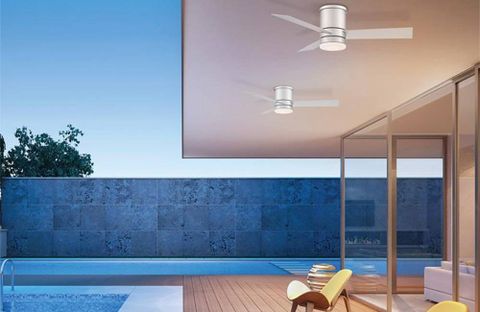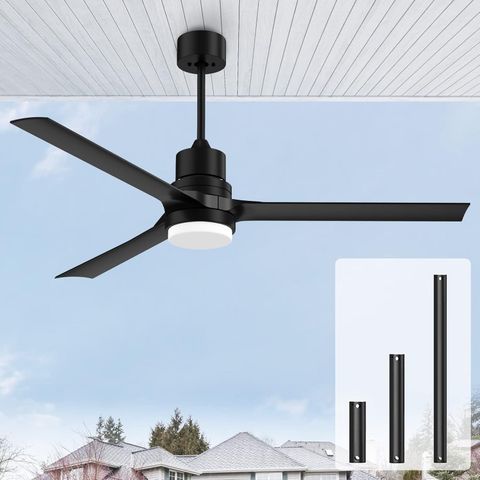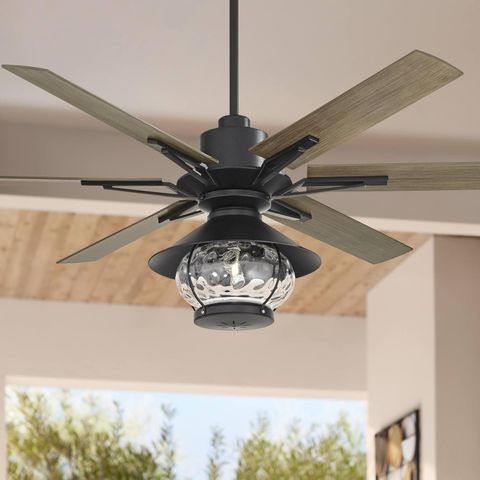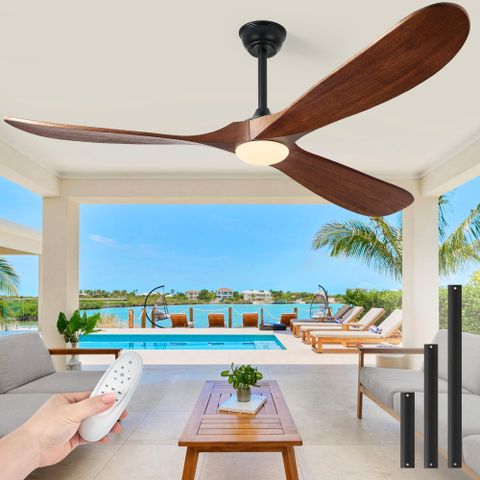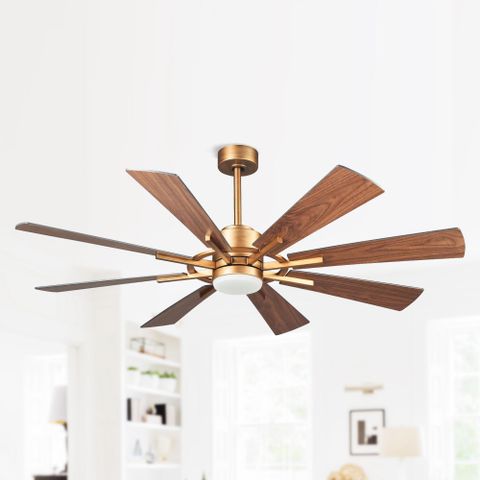Imagine stepping from your cozy living room into a breezy covered patio, feeling the same comfortable air flow without the abrupt change in environment. That seamless transition isn’t just a dream anymore. It’s achievable through smart ceiling fan choices that connect indoor and outdoor spaces.
When we talk about indoor-outdoor living spaces, we’re not just talking about aesthetics or design trends. We’re discussing lifestyle evolution, where the boundaries between inside and outside become fluid. The right ceiling fans can be the invisible thread that weaves these environments together. They don’t just provide cooling; they create continuity of experience. Think about it – when you’re sitting in your kitchen, feeling the gentle breeze from your dining area, or when you step from a covered porch into a sun-drenched garden, the air movement should feel natural and consistent.
Understanding the Psychology of Air Movement
Air movement isn’t just about temperature control. It’s deeply connected to our sense of comfort and well-being. When we move through spaces, our bodies naturally adapt to changing air conditions. The sudden shift from still air to strong airflow can be jarring. But when we maintain consistent air movement across different areas, we’re essentially creating a sensory bridge.
Consider how we feel when walking from a cool, air-conditioned office into a warm, sunlit lobby. Our bodies immediately adjust to the temperature change. Now imagine if that transition were smoother – if the air moved gently from one space to another, almost like a breath of fresh air flowing through a corridor. This is exactly what thoughtful ceiling fan placement can achieve.
Research shows that consistent air circulation helps reduce stress levels and improves mental clarity. When you’re moving between spaces without feeling the abrupt change in air dynamics, your body doesn’t have to work as hard to adjust. It’s like having a gentle guide leading you from one environment to another.
Choosing the Right Size for Your Space
This might seem obvious, but size matters more than you think when creating seamless transitions. A ceiling fan that’s too small for a large open area will create uneven airflow. It’s like trying to cover a football field with a single sprinkler system that’s meant for a small garden.
For spaces that blend indoors and outdoors, consider the total square footage. A 16-foot by 16-foot covered patio needs a different approach than a 12-foot by 12-foot space. The bigger the area, the more powerful the fan needs to be to maintain consistent airflow.
Let’s look at a real example: a couple renovated their home with a large, open-concept kitchen that flows into a covered deck. They initially installed two small fans – one in the kitchen and one on the deck. The result? Uneven air circulation. The kitchen felt stuffy while the deck had a strong breeze. They switched to one larger, more powerful fan positioned strategically between the two areas. Suddenly, the air moved smoothly from one zone to the next, creating that seamless transition they’d been seeking.
Here are some basic guidelines:
• Small spaces (under 100 sq ft): 36-inch fan
• Medium spaces (100-300 sq ft): 42-inch fan
• Large spaces (over 300 sq ft): 52-inch fan or larger
The Importance of Blade Design and Speed Control
Not all ceiling fans are created equal, especially when it comes to creating that natural flow between indoor and outdoor settings. The blades themselves play a crucial role in how air moves through a space.
Traditional blade designs often create a direct, sometimes harsh airflow. But modern fans offer various blade shapes and angles designed specifically for creating gentle, diffused air movement. Some fans even feature curved blades that mimic natural wind patterns, providing a more organic feeling.
Speed control becomes even more important when transitioning between spaces. You want to be able to adjust airflow without creating a dramatic shift. A fan with multiple speed settings allows you to fine-tune the experience. Maybe you want a gentle breeze during morning coffee in your covered porch, but need stronger airflow for afternoon entertaining in the same area.
Consider the difference between a fan that only offers high/low settings versus one with multiple speeds. The latter gives you the flexibility to create micro-climates within larger spaces. It’s like having a thermostat that can adjust not just temperature but also the quality of the air movement itself.
The material of the blades also matters. Wood blades often provide a more natural feel compared to plastic or metal, especially in outdoor settings where they can complement rustic or traditional designs.
Weather Resistance and Outdoor Durability
If you’re creating seamless indoor-outdoor living spaces, you can’t ignore the weather factor. The best fan in the world won’t serve you well if it’s exposed to rain, sun, and humidity without proper protection.
Outdoor ceiling fans require special consideration. They need to be rated for outdoor use, meaning they can handle moisture, UV exposure, and temperature fluctuations. Look for fans with wet-rated motors and corrosion-resistant materials.
Many people assume that because a fan is labeled as "outdoor," it’s automatically suitable for all conditions. But there’s a big difference between a fan designed for a covered porch and one meant for an uncovered patio. The latter requires additional protection against direct weather exposure.
A good rule of thumb: if you’re installing a fan in a partially covered area, ensure it has proper weatherproofing. For completely uncovered spaces, you’ll want fans specifically designed for those conditions.
Take the example of a family who installed a beautiful outdoor fan in their uncovered patio. Within months, the motor failed due to exposure to the elements. They learned that even "outdoor" fans have limits. The solution was replacing it with a properly rated fan that could withstand their local climate conditions.
Key features to look for:
• Wet-rated motor
• Corrosion-resistant materials
• UV protection
• Proper mounting hardware for outdoor installation
• Weatherproof finishes
Integration with Existing Lighting and Design Elements
The beauty of thoughtful ceiling fan selection lies in its ability to enhance rather than compete with existing design elements. In seamless indoor-outdoor spaces, every element should contribute to the overall harmony.
Lighting integration is particularly important. Many modern ceiling fans come with integrated lighting options, allowing you to maintain consistent illumination levels as you move between spaces. Imagine having the same ambient light quality whether you’re in your dining room or your covered patio.
But it’s not just about matching colors or styles. The fan should complement the architectural flow of your space. If you have high ceilings that flow into a covered area, you might want a fan with a longer downrod to maintain proportionality.
Consider the overall aesthetic. A sleek, modern fan might clash with a rustic outdoor setting, while a traditional fan could overwhelm a contemporary indoor space. The key is finding balance.
One client shared how they struggled with their new ceiling fan until they realized it was too ornate for their minimalist indoor-outdoor setup. They replaced it with a simpler, more streamlined model that still provided excellent airflow but blended better with both environments.
Additional considerations:
• Matching finish with existing fixtures
• Proportional sizing with room dimensions
• Integration with lighting schemes
• Complementary design elements
Energy Efficiency and Smart Technology Options
In today’s environmentally conscious world, energy efficiency shouldn’t be overlooked when choosing ceiling fans for seamless indoor-outdoor spaces. The right technology can make your life easier while reducing your environmental impact.
Modern fans offer variable speed controls, timers, and even smart home integration capabilities. These features allow you to optimize energy usage based on occupancy and time of day. You wouldn’t want to run a powerful fan continuously when the space is empty, especially in outdoor areas where energy costs can add up.
Smart fans can learn your preferences over time, adjusting airflow automatically based on temperature, humidity, and even time of day. Some models can even integrate with weather apps to adjust operation based on predicted conditions.
There’s something satisfying about a fan that works intelligently with your lifestyle. It’s not just about convenience; it’s about creating a sustainable relationship with your living environment.
For example, a homeowner installed a smart fan system that automatically reduced speed during evening hours when the temperature dropped naturally. They saved significant energy costs while maintaining comfort. The system also learned their schedule, turning off when they left for work and restarting before they returned home.
Important features to consider:
• Energy-efficient motors
• Variable speed controls
• Smart home compatibility
• Timer functions
• Motion sensors
• App control capabilities
The journey toward seamless indoor-outdoor living spaces isn’t just about aesthetics or comfort – it’s about creating a living environment that feels natural and intuitive. When you carefully choose your ceiling fans, you’re essentially designing a system that supports your daily rhythms and enhances your connection to both your home and its surroundings.
It’s easy to get caught up in the details – size, style, price – but remember that the ultimate goal is the experience itself. How does the air feel as you move between spaces? Does it create a sense of continuity or disruption? Do you feel like you’re truly part of one unified environment?
The right ceiling fan choices can transform your home from a collection of separate rooms into a cohesive living space that flows naturally with your lifestyle. Whether you’re hosting guests, enjoying quiet moments alone, or simply moving from one area to another, thoughtful fan selection ensures that your environment responds to you rather than forcing you to adapt to it.
The investment in quality, appropriately-sized fans with weather resistance and smart features pays dividends in comfort, energy savings, and overall satisfaction. It’s about making your home feel like a true extension of your outdoor lifestyle, where the transition between indoor and outdoor spaces is barely noticed – and that’s the kind of seamless living that makes every day feel a little more effortless.

